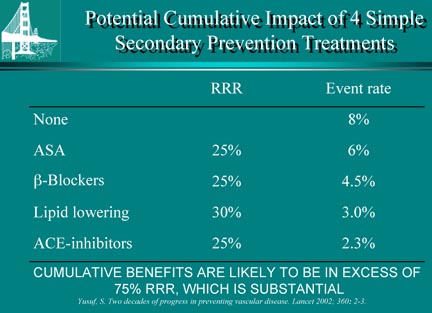CVD in Elderly
Prevention of Cardiovascular Events in the Elderly
Advancing age is one of the strongest risk factors for cardiovascular
events in our population. Elderly patients with established vascular
disease or longstanding type II diabetes are likely to derive the greatest
benefit from interventions that aim to reduce the global cardiovascular
risk. However many risk factors associated with cardiovascular disease
decline in importance with advancing age. Until recently, clinical
trials have not addressed risk factor control in the elderly either
with or without established vascular disease. Evidence is now increasing
to indicate that global vascular risk reduction is beneficial in the
older population.
GERIOVASCULAR PREVENTION may be defined as the prevention of all first
and recurrent cardiovascular events in the elderly. This includes prevention
of fatal and non-fatal stroke, fatal and non fatal ST elevation (STEMI)
and non-ST elevation myocardial infarction (NSTEMI) , transient ischaemic
attack (TIA), reversible ischaemic neurologic deficit(RIND), acute coronary
syndrome(ACS) and prevention of the need for revascularization: carotid
endarterectomy or percutaneous intervention (PCI), coronary PCI or coronary
bypass surgery and peripheral vascular surgery for occlusive disease
and aortic aneurysms, and related hospitalizations and morbidity. Whereas
in primary prevention of coronary heart disease (CHD) in the elderly,
many risk factors decline in importance with advancing age, in the secondary
prevention population i.e. those with established vascular disease, be
it cerebrovascular, coronary or peripheral vascular disease, or longstanding
type II diabetes, the attributable risk of various co-morbidities remains
significant. Global cardiovascular risk assessment must necessarily give
way to global “GERIOVASCULAR” risk interventions in these
high-risk populations targeting global cardiovascular risk reduction
to yield the greatest benefits in terms of event and mortality reduction.
The goals of cardiovascular prevention in the elderly are not only to
prevent morbidity and mortality but to preserve function and prevent
frailty, to keep the well elderly well and to prevent the frail elderly
from deteriorating and in so doing improve quality of life. In essence
the goal is to postpone and compress the period of cardiovascular morbidity
as much as possible to minimize disability. In order to accomplish this,
we must more effectively and consistently prevent and treat diabetes,
stroke and heart disease in the elderly.

Yusuf, S. Two decades of progress in preventing vascular disease. Lancet
2002; 360: 2-3.
|